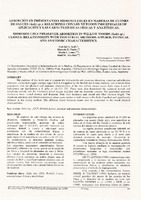Absorción de preservantes hidrosolubles en maderas de clones de sauces (Salix sp.) : relaciones con los métodos industriales de aplicación y las características físicas y anatómicas
Hidrosoluble preserver absortion in willow woods (salix sp.)clones : relationships with industrial methods applied, physical and anatomic characteristics
Date
2000-12-01Author
Keil, Gabriel G.
Otaño, Marcelo Eduardo
Luna, María Luján
Marlats, Raúl Marcos
Metadata
Show full item recordAbstract
El objetivo de este trabajo fue evaluar la absorción, retención y retención efectiva del preservante hidrosoluble: arseniato de cobre cromatado tipo C (CCA-C), aplicado mediante los métodos Bethell y Lowry y relacionar estos parámetros con las características físicas y anatómicas de la madera de dos clones de sauce: Salix nigra 4 y S. babylcinica x S. alba cv (A-131-25).
Se determinaron: la densidad aparente normal, anhidra y básica, junto con el contenido de humedad. Los caracteres anatómicos cuantificados fueron: densidad y diámetro de vasos; grosor de la pared de las fibras y longitud de elementos de vaso y fibras.
Los valores de absorción retención y retención efectiva fueron similares en ambos clones para el método Bethell y significativamente distintos para el método Lowry. Las diferencias encontradas entre clones pueden asociarse a las características físicas de las maderas. The purpose of this work was to evaluate the hidrosoluble salt preserver absortion, retention and effective retention: chromated copper arsenate type C(CCA-C) applied by the Bethell and Lowry methods, and to relate these parameters with the physical and anatomic characteristics of the two willow clones wood: Salix nigra 4 and S. babylonica var Sacramenta x S. alba cv(A-131-25). There were also determined the apparent normal and anhydrous density and the volumetric dried weigth, together with the humidity content. The quantified anatomic characters were: vessel density and diameter, fiber wall thickness and vessel and fiber element length. The absortion, retention and effective retention values were similar in both clones in the Bethell method and significantly different in the Lowry method. The different found between clones may be associated to the wood physical characteristics.
Collections
- Revista Yvyraretá [360]
The following license files are associated with this item:




